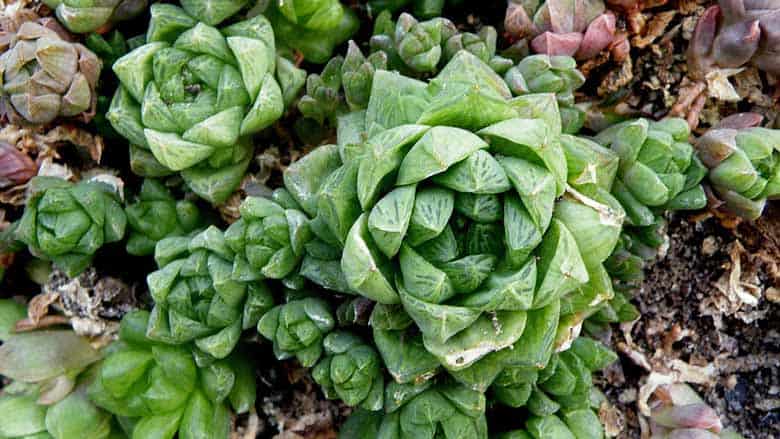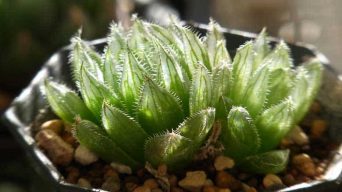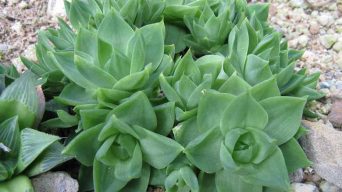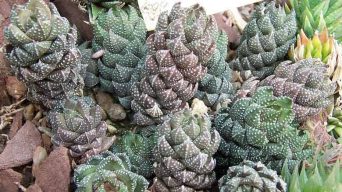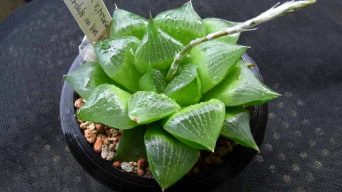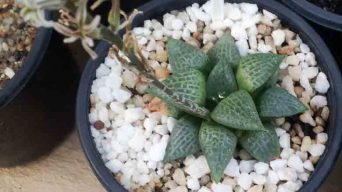Growing succulents is a popular hobby these days. Many people are drawn to the low-maintenance lifestyle they provide and find themselves creating little gardens of different varieties all over their homes.
One plant that seems to be especially popular right now is Haworthia Obtusa.
However, some gardeners may not know how best to take care of it or propagate it for more plants in the future.
This article will walk you through everything you need to know about Haworthia obtusa care and propagation!
How To Care for Haworthia Obtusa
Haworthia obtusa is a range of succulents that originate from Eastern Africa. They generally have an oval shape and grow in dense clusters, forming large clumps.
They also grow to be about 3-4 inches tall, with their leaves being smaller than the other varieties of Haworthias.
Haworthia obtusa plants have a thick, fleshy stem, and bright green leaves.
They also have small pockets that can be seen on the top of their leaves where water is stored during dry periods.
These succulents store so much water because they grow in areas with very little rainfall.
Haworthia obtusa plants are easy to care for and can be grown in both indoor or outdoor environments.
The Haworthia genus is one of the easiest succulents to grow due to its hardy nature.
Sun Exposure & Light Requirements
The Haworthia succulent likes bright light. It does not like full sun but prefers light shade or indirect sunlight.
Too much direct sun will burn the leaves and cause them to curl up, as well as weakening their stems and slowing down growth.
Haworthia species do best in semi-shade or partial shade locations where they can get some morning sun with more protection from midday hot afternoon rays!
If you want to make sure that your succulent plant receives enough light and water, turn it around every week. This works well for plants grown under lights and also outside in gardens.
The only exception here is when planting in the ground outdoors. If you are planting a succulent in soil, then the morning sun is best to encourage growth and reduce water needs for that plant.
Watering
Haworthia obtusa succulents are native to the Eastern Cape of South Africa and grow in a dry climate.
Succulent plants need very little water, especially during wintertime when they should be watered less often.
Haworthias can be given more frequent light watering sessions during summertime, but this is not necessary if your plant has good drainage (which most do).
In general, you want to let these succulents get almost completely dry before watering them again.
If it’s in a container, water the soil mix, not the plant. The top inch of potting mix should be dry before watering again.
It would be best if you waited until the ground is dry all the way through before watering your plant.
Then put enough water on it so that some of it spills out onto the tray or saucer under your Haworthia Obtusa succulent.
Take care not to over-water and prevent any excess water from collecting in your pot. Too much moisture can lead to root rot or other fungal infections, which will kill the plant if left untreated.
Haworthias also appreciate deep watering every once in a while; this means that you should fill up the pot with enough water so it’s about an inch from the top.
Soil Requirements
The soil should be well-draining and not too rich in nutrients.
A cactus potting mix is a good starting point. Still, you can also modify it with sand, perlite, or vermiculite to make it more suitable for this plant.
If you are propagating the plant, use a mixture of 50% sand with 50% potting soil (this will help hold water better).
For established plants, it’s best to fill up the container as much as possible and then add some pebbles for drainage at the bottom.
Make sure not to cover too many roots in this process, or they won’t get enough oxygen.
If planted by themselves without pots or containers, place them on top of rocks to prevent rotting roots due to excess water collection at ground level during wet periods.
Temperature and Humidity Requirements
Haworthia obtusa can thrive in a wide variety of temperature and humidity levels.
Still, they do best with daytime temperatures around 75-85 degrees Fahrenheit and nighttime temperatures that drop to about 55-60 degrees Fahrenheit.
They are native to South Africa, so the care level is similar as well.
To simulate this environment year-round indoors, you will need an overhead light (not fluorescent) during the day and a 60-watt bulb or higher at night for 12 hours each time.
It would help if you also aimed for a relative humidity between 40% – 70%.
Cold Weather Considerations
When it gets cold outside, H. Obtusa may become dormant, meaning their leaves will shrivel on the plant’s body until warmer weather returns.
If your plants are in a pot, make sure you only water when needed and don’t provide any fertilizer or supplemental light.
If your plants are potted outside during the winter, be careful not to let them freeze (check on them every day).
Fertilizing Haworthia Obtusa
Some people might not know this, but Haworthia plants are sensitive to fertilizers.
Too much fertilizer can damage the roots and leaves of these succulent plants, so be careful when applying it.
It would help if you only used a weak or diluted fertilizer solution on your Haworthias once every two months during the summer season (June-October).
If you’re using powders instead of liquid solutions, mix them in with some water before application.
One teaspoon per gallon is usually enough for most succulents like Haworthia fasciata or H. truncate var frithii varieties.
Too little will result in poor growth, while too much may kill off all your plant’s leaves.
However, the Haworthia Obtusa variety is different from others. It can handle stronger fertilizers more easily than some other succulents like Haworthia truncate var frithii or Haworthia fasciata varieties.
This means that you should use a concentrated fertilizer solution twice monthly during the summer (June-October).
This will ensure maximum growth and health in your plant’s leaves as well as its root system.
Potting and Repotting
A Haworthia plant typically needs to be potted once they start forming roots – not before.
When potting the plant, it’s important to make sure that there are no air pockets below the soil line, or else this can result in rot.
This means that you should use your hands instead of utensils. Fingers have more tactility than spoons for feeling around the bottom of pots for any space where water could collect and cause root rot.
The best time to repot plants with shallow root systems would be during their winter dormancy period when the watering frequency has decreased and the growth rate slows down.
Preventing Transplant Shock
Transplant shock can happen when plants move from one environment to another.
Its impact on succulents is especially troublesome because their shallow roots don’t offer much stability for the plant to support itself during this time of stress.
Now that you’ve transplanted your Haworthia, make sure they have enough water. Also, give them six hours of sunlight each day for the next two months.
The easiest way to provide these conditions is by setting up a grow light that will mimic natural outdoor daylight.
This artificial lighting will help Haworthias recover faster and make the process easier on them.
The other factor to consider is that some succulents do well when you’re continually moving plants around their environment.
In contrast, others need time to adjust before they can be transplanted again (this will depend on how often they’ve been moved in the past).
Haworthias fall into this latter category of needing a period where it’s just best to leave them alone for an extended period of time – at least six months after transplanting.
You should also avoid any type of fertilizers or soil amendments during this adjustment phase, as these may cause root rot.
Once the haworthia has grown back its old leaves, it can usually handle being moved without getting too stressed out.
Pruning
Pruning Haworthia obtusa is not required.
However, if you want to keep the indoor plant in a smaller size and shape or divide it into new plants, then pruning will be necessary.
Prune when there are at least three-four eyes on your leaves so that there is enough energy stored for regeneration growth.
Use sterile scissors to cut through the leaf, leaving one eye per leaf intact before potting up the individual stem cuttings.
Keep your cuttings moist until they are ready to be potted.
You can do this by putting them in water or dipping them in a cup of water. This will keep the cuttings from drying out before they are ready to be planted.
Pests and Diseases
Haworthia obtusa is usually resistant to pests, but the following are known to attack them:
- Mealybugs
- Thrips
- Bacterial spot of leaves and stems, caused by Pseudomonas cichorii.
Mealybugs can be treated with soapwort or neem oil in a spray bottle.
Thrips and bacteria can be dealt with using hot water treatments. This will wash off all pest debris from the plant’s surfaces when sprayed on at least twice per week for two weeks consecutively.
When plants start to recover, you don’t need to spray them every day. You can spray them once every four days.
However, it is best to prevent pest infestation by planting your succulent in a pot with good drainage and providing adequate sunlight.
The Haworthia Obtusa also has some resistance to drought, which can help protect the plant from drying out while watering less often than usual.
It will take longer for pests or diseases to appear when watered well.
A common problem with the Haworthia Obtusa is that its leaves dry up due to overwatering.
They need water but not too much at once as this may lead them to rotting or fungal growths on their stem joints where water pools around them.
How To Propagate Haworthia Obtusa
Haworthia obtusa can be propagated by leaf cuttings, stem cuttings, and offsets.
Leaf Cutting
Haworthia obtusa plants can be propagated by leaf-cuttings for small or medium sizes of the plant.
For a large size Haworthia, collect leaves from the bottom half of the mother plant to avoid damaging them when you move them off its potting media and onto a propagation tray.
Follow these steps to complete the propagation of your Haworthia by leaf-cutting:
- Take a clean and sharp pair of scissors and carefully cut around the edge of the lower leaves on your mother plant. Be sure not to damage any other parts like roots or flowers.
- Place a small amount of moist sphagnum moss in each cell with an empty hole at the bottom (make them as deep as possible).
- Shake off excess water from removed leaves before placing them onto freshly moistened sphagnum moss. Abundant watering will result in rotten young plants, so be careful about how much you give it.
- Press down firmly on top of the new cutting for 15 minutes, then remove your hand to allow the new plant space for air circulation.
- Keep your propagation tray in a well-lit location out of the direct sun with plenty of ambient temperature and humidity.
Most people find that leaves are best harvested when they reach the desired size but before they break away on their own.
Cut at least two sets per succulent leaf so that there’s enough food still available for both plants until the next harvest cycle begins anew.
Make sure not to forget about rooting hormone powder during these steps!
Repeat every three months to maintain a consistent, stable supply of your favorite plant.
Stem Cutting
Stem cutting is also another way to propagate Haworthia obtusa succulent plants.
Cut a healthy branch at least three inches long with one or two nodes with a nice fat node base (the swelling under where leaves usually form).
The lower part should include about five pairs of leaves attached tightly along each side of the stem.
Remove any leaves in contact with the compost or soil, as they may rot and cause problems later on down the road if left attached to cuttings.
Make a shallow diagonal cut at least one inch below where you want your plant to stop growing, following either side of the node base around it.
Carefully remove each leaf from this part of the cutting while being careful not to damage its roots so that there is no chance of desiccation (drying out).
Leave about two inches of space between nodes before making another cut an inch further up along either side.
Repeat every few cuts until you reach three inches above ground level when adding new rooting hormone powder into each newly created section.
For best results, try to keep the plant in a bright location without direct sunlight that could burn its leaves.
They do not need much water and will thrive with only one watering every two weeks during winter or dry periods.
You can also place them outside in a rock garden for partial sun exposure, where they are less likely to be harmed by a freeze if put out at night when it is coldest.
Offsets
The offsetting process is a method of propagation that will increase the plant’s beauty by creating more specimens.
For ease in finding offsets, you want to try propagating Haworthia obtusa during summer when it has begun to put out daughter shoots or “pups.”
A good time frame would be late June through early September when the small off-shoots start emerging near the lower leaves on mature plants with heavy branching.
It is best not to take any pups until at least two pairs have appeared so that you don’t end up splitting them too close to the parent plant.
Cut any of these pups that are more than one inch in diameter from the stem. Leave about an inch and a half behind so that new roots can grow out there too.
At this point, you want to prepare your potting mix. Make sure it has plenty of good drainage so that water can drain away freely, which will help prevent root rot later on down the line.
Take a razor blade or very sharp knife, and make a small cut into the soil near the place where you want to put your plant.
Put some dirt inside of the hole that you made. Place the pups in the hole, making sure to leave space for their adult plants.
Toxicity
Haworthia obtusa is not poisonous. It does, however, contain oxalates that can lead to kidney stones and other health issues for those who are prone to them or have a history of these types of conditions.
If you know this about yourself or your family members, then avoiding eating the leaves (and touching them) is best. Just because they don’t taste good doesn’t mean that they’re toxic!
But just in case:
- Wash your hands after handling plants to avoid accidentally touching any part of the houseplant – especially the flowers and seed pods.
- Keep children away from large clusters of mature plants with their seeds on display.
- Wear protective gloves when you trim plants and remove dead leaves.
- Don’t eat the plant or any part of it, including flowers or seed pods.
- If you have a history of kidney stones or are prone to them, avoid touching mature plants with their seeds on display. They may contain oxalates that could lead to health issues for you.
Final Thoughts
If you are looking for a beginner plant with an easy-to-care-for succulent, then the Haworthia Obtusa is perfect.
It grows well in full sunlight and can survive variable temperatures.
This species of flowering succulent will thrive when planted outdoors or indoors as long as it has enough light exposure and water during hot days.
The leaves of this succulent also make incredible decorations that bring out its pastel colors!

